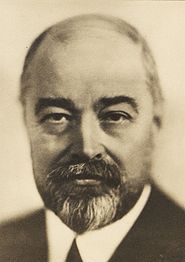



Paul Bigot (20 October 1870 – 8 June 1942) was a French architect.
Biography
Bigot was born in Orbec, Calvados. He studied architecture at the École nationale supérieure des Beaux-Arts in Paris, in the atelier of Louis-Jules André. He won the Grand Prix de Rome in 1900, which enabled him to study in Rome at the Villa Medici. He later became a professor at the École des Beaux-Arts.
He is particularly known for his "Plan of Rome [fr]", a large architectural model of Ancient Rome. It is a plaster model of about 70 square metres at a scale of 1:400, showing Rome as it would have been in the time of the emperor Constantine I (4th century AD). The model is preserved at the University of Caen and is itself listed as an ancient monument. A second version is in the Royal Museums of Art and History in Brussels.
Bigot was the architect of the Institut d'Art et d'Archéologie, in Paris, completed in 1932.
Works
- 1908-1942: Plan de Rome, a large model of Rome in 350 CE.
- 1920-1932: Institut d'Art et d'Archéologie, Paris
- 1922: reconstruction of the town of Fargniers following its comprehensive destruction during World War I, in association with Henri Paul Nénot, financed by the Carnegie Endowment for International Peace
- 1924-1934: reconstruction of the neighborhood around the Saint-Quentin station in Saint-Quentin, including the Monument aux Morts with sculptors Henri Bouchard and Paul Landowski
- 1930: Monument of the First Battle of the Marne in Mondement
- 1933: Monument to Aristide Briand on the Quai d'Orsay, Paris, with Henri Bouchard and Paul Landowski
- 1935: refurbishment of Hôtel Matignon as office and residence of the French Prime Minister
- 1935-1939: expansion of the Ministry of Foreign Affairs
- 1936: Monument to Ferdinand Foch, Paris, with sculptor Robert Wlérick [fr]
See also
References
Notes
- Simon Texier, ed. (2005), L'Institut d'art et d'archéologie, Paris 1932, Paris: Picard, pp. 25–27
External links
- Le Plan de Rome website at University of Caen
- Biography: "Paul Bigot: a Norman in Rome"
- Modern Mechanix: Model of Rome Took Thirty Years to Build (Jun, 1934)
- See: Designed / created by Arch. Paul Bigot ("Prix de Rome"), c. 1906–1911. News Report: REMARKABLE RESTORATION OF THE ANCIENT CITY MADE IN MODEL, THE NEW YORK TIMES (26-11-1911, pg. SM8). cf.
- Martin. G. Conde, Rome. Model's of Ancient Rome : Giuseppe Marcelliani (1905–1906); Paul Bigot (1906–1911, 1942); Italo Gismondi / Pierino Di Carlo (1933–1937, & later revisions).
- Works by Paul Bigot